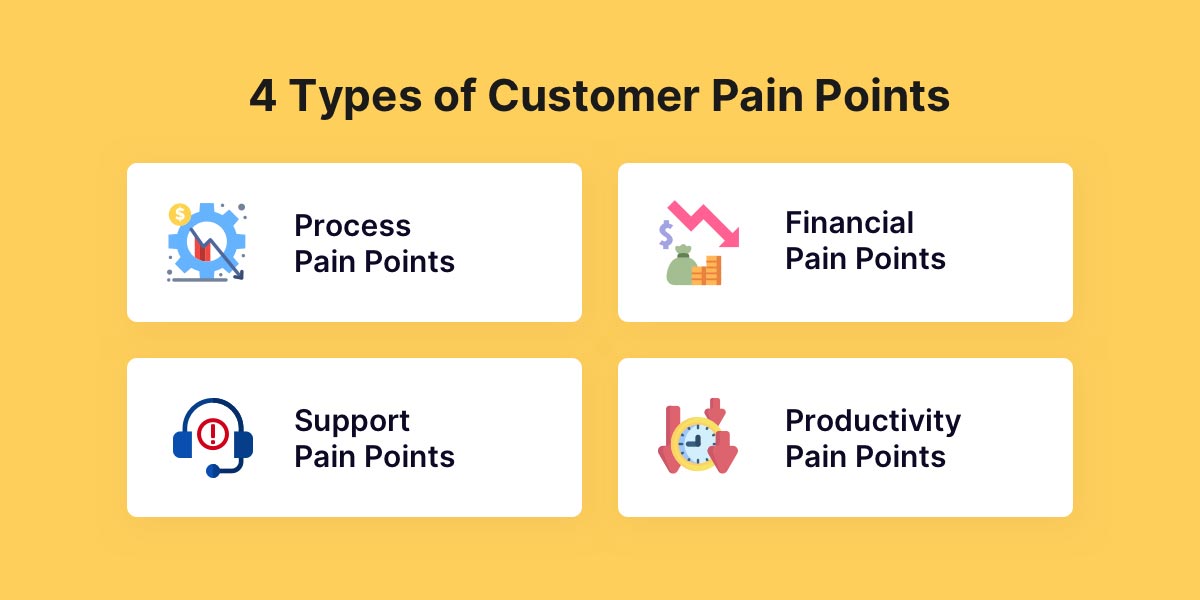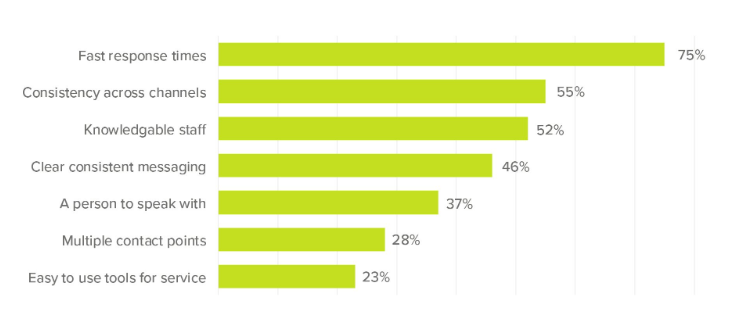Customer Pain Points: How to Identify and Resolve Them
- July 15, 2020
- 18 mins read
- Listen

No matter how successful, every business faces one common challenge: customer pain points. Whether it’s long wait times, unresponsive support, or unclear product information, these frustrations can lead to customer churn, negative reviews, and lost revenue.
In fact, according to a recent survey, 96% of customers will leave a company after a single bad experience. That’s a staggering figure for any business aiming to retain loyal customers.
But what exactly are these pain points, and how can businesses effectively resolve them? The smallest friction in the customer journey can snowball into bigger issues, from communication breakdowns to product misunderstandings.
In this article, you will discover the most common customer pain points, backed by industry data. You will also be able to offer actionable solutions to transform your customer experience. Let’s dig in!
What are Customer Pain Points?
A customer pain point can be defined as a specific problem your customer or prospect experiences during all the interactions across different touchpoints.
The very first step for businesses is to understand what customers want should be part of your customer service strategy. By identifying pain points, businesses and entrepreneurs can craft an appropriate value proposition that attracts customers to resolve their problems.
Types of Customer Pain Points
If you don’t understand your customers’ pain points, how are you going to solve their problems?
Every business builds products or services to resolve specific customer problems. By having an in-depth customer pain point analysis, you can group them into four broad categories.
Support Pain Points
Customer support is one of the important business functions. With improper support, most of the crucial areas are impacted. Customers may have product-related queries and most of them would expect prompt customer support. Some common support issues are:
- Delayed response
- Lack of product knowledge
- Not available on customers’ preferred channel
When entrepreneurs fail to deliver the right solution to the above customer pain, it impacts customer retention & loyalty.
Pro Tip
One of the best ways to exceed your customer’s expectations is by helping them in real-time, with digital engagement tools like live chat, co-browsing, and AI chatbots.
Productivity Pain Points
The process pain points are when the customer expects a more streamlined experience when getting in touch with businesses. They want to make the most of their time to avoid frustration. Some examples of productivity pain points are:
- Inconvenience in using the product
- Redundancy and friction in the buying process
Pro Tip
Businesses need to convince their customers that their product is the key to saving time and effort. You can use images and product descriptions that explain how your product helps practically.
Financial Pain Points
The financial pain points indicate the pain of spending an excessive amount of money on the current business that ends up with financial strain. The financial pain point of customers can be:
- Subscription plans or membership fees
- A high cost of repeat purchases
Pro Tip
The main goal for businesses should be to prove to the potential customers the right value they will perceive in choosing your products.
Process Pain Points
The process pain points refer to how businesses interact with customers by choosing different methodologies and processes. The process-related pain points can be:
- Connecting to the right department
- Application Submission
Pro Tip
Brands need to ensure that they are able to meet customer queries faster with the right team and by persuading their prospects that your products/services are easier to use.
How to Identify Customer Pain Points?
Discovering customer pain points impacts both your sales and marketing strategy. The sales team identifies the pain points so as to tailor their pitch and present the products as the right solution. And marketers want to understand these pain points so that they can advertise their solutions effectively in an appealing way.
That’s why identifying client pain points is so crucial. Conducting pain point analysis is an essential stage in improving the experience of different types of customers. Let us discuss the proven ways to figure out consumer pain points.
Conduct Qualitative Market Research
It is very important to discover exactly what your customers want. Conducting a qualitative market study includes mapping customer journeys and evaluating data regarding customer pain points. Some vital steps for conducting research are:
- Map out your customer journeys give businesses gain valuable insights and understanding regarding common customer pain points.
- Create customer personas to focus your time on qualified prospects, guide product development as per customer needs, and align all work across your business.
Listen to Your Customers to Identify Pain Points
One of the best ways to identify customers’ problems is by listening to them. Solving the problem by knowing it first through the perspective of a customer is the best way to handle it. Here are the key reasons why listening to customers is beneficial.
- Bad customer service is one main reason for customer churn. On the other hand, customers are happy to pay more, if they receive a better customer experience.
- When support reps listen to customers, service interactions tend to be smoother. The frictionless experience has a great impact on your customer retention strategies.
Use Live Chat to Identify Customer Pain Points
In order to effectively manage customer pain points, businesses first need to develop trust and confidence before offering solutions to customers. Adding live chat is a great way to know customer demands and the issues they are facing. Here is how live chat helps to discover customer pain points and offer effective solutions.
- By enabling instant connectivity with clients via live chat, you can immediately determine their needs and provide products/services that best meet their interests.
- The benefit of using live chat to identify client pain points is that your agents can understand every issue to the best of their abilities and offer timely solutions.
By using live chat, your agents will get tons of customer-driven data and find issues that often frustrate customers. Start a free trial of live chat with REVE Chat and take a solid first step ahead towards identifying customer pain points.
Talk to Your Sales and Customer Support Teams
62% of customers want marketing content that speaks to pain points. Regular conversations with your customer-facing teams, be it sales, customer, or marketing teams help to gain valuable insights into your customer perception. Here are the key benefits of having regular conversations with your teams.
- It helps you to identify the customer pain points as well as the core strengths of your brand as a whole.
- Keeping in regular touch with the respective teams can help you to understand and categorize the pain points.
8 Common Customer Pain Points Every Business Faces
When businesses have a fair idea about their client’s pain points, it becomes easier for them to approach them in the right manner. By using the right tools and strategies, you can deliver a consistent experience across customer touchpoints. Let us discuss innovative ways to fix the customer pain points across the customer journey.
1. Delayed Support Response
Being in a long queue to get assistance is one of the biggest customer pain points. Delays in response time can frustrate customers and create a negative service experience. Unhappy customers are more likely to share their experience with bad word of mouth.
Your goal should be to respond and solve all customer issues quickly and go above and beyond customers’ expectations. 82% of customers say the number one factor to great customer service is having their issues resolved quickly.
A faster response is a key attribute of customer experience.
Pro Tips
- Faster response is a key attribute of CX – customer pain points
- Here are the key tools that can deliver real-time responses and resolve client pain points.
- Deliver real-time sales and support assistance to all queries with live chat to boost customer satisfaction.
With live engagement tools like co-browsing & video chat, you can provide faster support and reduce the number of touchpoints. Video chat helps to identify issues faster and offers effective solutions in the first go via personalized chat.
2. Inconsistent Customer Experience
65% of customers expressed frustration over inconsistent experiences or information presented across channels. Distrust builds when companies create inconsistent experiences across channels.
Customers reach out to businesses across various online and offline channels and expect consistent support across all channels. As you build and evolve your customer experience (CX) practices, you need to avoid frustrations that can drive customers away. You need to know that omnichannel customer experience is the new norm.
By understanding recent shifts in the customer buying landscape and the multiple dimensions of CX consistency, you can design the right approaches to develop lasting relationships with your customers.
Pro Tips
- Understand your customers’ expectations. Their needs are what drive your business, so keeping them at the forefront of your customer experience mindset only makes sense.
- Articulate your company’s customer experience mission statement and distribute it to your employees. Much like prioritizing your customers provides guidance for delivering top-quality experiences.
- Omnichannel customer experience demands consistency. Delivering consistent support experience across various platforms is the key to customer satisfaction.
3. Non-availability of the Support Team
Delivering 24/7 customer support is a common customer pain point to solve. Scaling the support team comes with some unique considerations that range from additional costs to extra time. Enhancing your availability to engage customers 24×7 is vital for acquiring and retaining customers. Here are several ways to make sure your customer service is “always-on”.
- You can deploy chatbots to automate your customer support tasks to deliver prompt responses 24×7 during peak hours or when your support team is unavailable.
- Self-service portals provide customers with instant access to information at the moment they want it most. It helps end-users as the first line of support and empowers those customers to find information to resolve their issues.
Pro Tips
Balance your support tasks with both live chat and chatbot to deliver a better conversational experience. With bots as the primary contact, you can answer simple queries and transfer complex chats to the support agents for effective handling.
4. Poor Quality of Products & Services
Having a poor-quality product is one of the most common customer pain points faced by small businesses or enterprises. Brands and marketers can’t afford to overlook product quality as it has a direct impact on increasing customer retention, building brand trust, and boosting your ROI.
Perfecting product quality has numerous benefits for any company. The positive correlation between product quality and sales should be reason enough to make quality a top priority in a business strategy.
Pro Tips
The trust, credibility, and loyalty that come from happy customers build repeat sales and ignite positive recommendations about a product that helps a company reach new audiences.
5. Lack of Adequate Knowledge & Experience
Today’s customers expect agents to have increasingly detailed knowledge of products, services, and company policies so they can achieve first contact resolution (FCR). Not being able to receive updated brand information becomes frustrating for customers.
Customers lose trust when they encounter agents who do not understand their products, services, or the importance of contributing to a positive experience. The expectation is that agents will be a reliable resource for guidance and resolution without having to expend exorbitant effort in explaining details.
Pro Tips
- Organize regular product training programs to give a continuous touch-up to the latest features of your product.
- Ensure that the new hires are experienced and have domain expertise that adds value to the service they offer to the customers.
6. Complicated Buying Process
Around 87% of customers abandon their carts during checkout if the process is too long or complicated. It means that you can really lose out if the UI/UX on the checkout page is poor.
Building up customers’ motivation is really key because we want to ensure that we’re making the most of an opportunity. This motivation means that we have to engage the customer and reduce all the barriers of conversion. The more we can engage, the more we can be compelling and sell to them.
Attracting visitors to your website, offering them a superior user experience, and making them buy from you are all challenging aspects in themselves. But keeping your customers interested in buying while they provide their personal and payment details on your checkout page is an even greater challenge.
Pro Tips
- Keep your sign up and check out the simple process. Simplicity really is best when it comes to designing the layout of your checkout page.
- Offer multiple payment options. Customers will complete the checkout process only if they have the option to pay through their preferred payment methods.
7. Tailor your Solutions to your Customer Needs
Businesses can not persuade customers if they do not want to buy unless you clearly understand what it is your customers really want.
Knowing and understanding customer needs is at the center of every successful business, whether it sells directly to individuals or other businesses. Once you have clear knowledge, you can use it to persuade potential and existing customers that buying from you is in their best interests.
Pro Tips
- Provide effective solutions: Every customer looks for an effective response in the first contact. By identifying the needs of your customers you can provide faster and effective support.
- Increase customer satisfaction: When the support issues are less, customers are happier. It also has a very positive effect on team productivity.
8. Rude Behavior of Support Representatives
Customers get frustrated when companies don’t “feel their pain.” It is expected that the severity of their issue will be recognized and responded to with the appropriate attention. If they are at risk of leaving, they want the company to acknowledge the issue and commit to taking action in order to save the relationship.
Quite possible that businesses might not be able to provide effective solutions all the time. But certainly, they can provide the right empathy phrases or words at all the points of interaction to deliver a positive experience. Being polite and empathetic helps in improving customer experience in healthcare to a great extent.
Pro Tips
With the proper empathy statements for customer service, you not only make your clients feel valued & heard but also level up the morale of your team. The biggest advantage of being polite and patient with customers is that businesses highly engage individuals.
Common Pain Point Examples
Effectively understanding and addressing customer pain points is crucial for building a positive customer experience. Below are some common pain points faced by customers, along with real-world examples and practical solutions to resolve them.
Price Sensitivity
One of the most frequent challenges customers face is affordability. High prices can deter customers from making purchases, especially when they see similar products at a lower price elsewhere. This is particularly common in industries like SaaS, where premium features are often bundled into expensive subscription tiers.
Example
A small business may be interested in your project management software but find the pricing too steep for the features they need. As a result, they look for cheaper alternatives, even if those lack the functionality they desire.
Solution
Offer flexible pricing models, such as pay-as-you-go plans or à la carte options, where customers can select and pay only for the features they need. Additionally, providing discounted pricing for long-term contracts or offering a free trial period can make your product more accessible to budget-conscious customers.
Slow Customer Support
Customers expect quick, efficient support whenever they encounter an issue. Your delaying responses or unhelpful solutions can leave them frustrated and negatively impact their experience with your brand.
Example
A customer trying to resolve a payment issue waits for hours or days to receive a response from your support team. In the meantime, they might lose trust in your brand and even consider switching to a competitor with more responsive customer service.
Solution
Invest in live chat tools or chatbots to offer real-time support, providing instant answers to common questions. Automating ticket routing systems can also ensure that urgent issues are prioritized. Additionally, training your support staff to provide more personalized, efficient service will help enhance customer satisfaction.
Complicated User Experience
Customers want simple, intuitive experiences when using a product or service. When processes are overly complex or poorly designed, they can become a source of frustration and lead customers to abandon your product.
Example
An e-commerce site with a complicated checkout process—such as multiple redirects or requiring too much information—can cause customers to abandon their cart mid-purchase, costing the business revenue.
Solution
Simplify the user journey by streamlining complex processes and ensuring the interface is easy to navigate. For example, minimize the steps in the checkout process and allow customers to store their information securely for faster future purchases. Additionally, offers helpful guides or tutorials for complex features to smooth the learning curve.
Lack of Personalization
Customers expect personalized experiences. Generic messaging or irrelevant offers can make them feel undervalued, reducing their engagement with your brand.
Example
A returning customer who frequently purchases fitness equipment receives generic promotional emails for unrelated products, making them feel like the brand doesn’t understand their preferences.
Solution
Leverage customer data to create personalized experiences, such as recommending products based on previous purchases or sending targeted emails with special offers. Personalized customer service, where support agents reference past interactions, also helps create a stronger connection between your brand and your customers.
Limited Self-Service Option
Many customers prefer to solve problems on their own without having to reach out to support. When self-service tools like FAQs, knowledge bases, or chatbot assistants are missing or difficult to find, customers feel trapped and frustrated.
Example
A software user encounters a minor bug but cannot find a troubleshooting guide online, forcing them to wait for the support team’s response. This delay could be avoided if there were easily accessible resources available.
Solution
Create a comprehensive knowledge base or help center where customers can find answers to common questions and resolve issues independently. Implementing AI-powered chatbots can also provide quick solutions by guiding users through common troubleshooting steps. This not only improves the customer experience but also reduces the load on your support team.
By identifying and addressing these common customer pain points, you can improve customer satisfaction, build stronger relationships, and retain loyalty. The key is not just to solve problems, but to proactively prevent them by continuously refining the customer experience.
How to Resolve Customer Pain Points
To understand how addressing customer pain points can lead to better outcomes, let’s explore a real-life scenario involving a retail business and a common problem: slow customer support.
Slow Response Time Frustrating Customers
Imagine you have an online fashion retailer that sells a wide range of clothing and accessories. During your seasonal sale, the customer service team is overwhelmed with queries about order status, returns, and product availability. One customer, Sarah, experiences a delay in receiving her order and tries to contact support. After several attempts and long waiting times, she becomes frustrated, leaving a negative review and considering shopping with a competitor next time.
Sarah’s main issue is the lack of quick, efficient support when she needs help with her delayed order. For the retailer, the problem lies in the inability to handle a surge in inquiries during busy periods.
Solution: Implementing a Hybrid Support System
To resolve this issue and prevent it from recurring, the retailer adopts a hybrid customer support system, combining AI-powered chatbots and Live Chat support agents. Here’s how the solution works:
Automated Chatbot for Instant Answers
You can introduce a chatbot on your website and mobile app. This can instantly answer frequently asked questions, such as checking order status, return policies, and product availability.
For example: Legrand is a global specialist in electrical and digital building infrastructures. They are using REVE Chatbot to reduce the number of basic inquiries going to the human support team and provide their customers with immediate assistance on their order delays.
Prioritizing Complex Issues for Human Agents
The chatbot is designed to identify more complex or sensitive issues (like complaints or requests for refunds) and routes tickets directly to a human agent. In Sarah’s case, once she flagged her issue as a delayed delivery, the chatbot could connect her with a Live Chat agent who could look into her order and provide a personalized update.
For example: PG Jewels is a famous manufacturer of crafted jewelry. They are using REVE Live Chat, and providing their customers with Instant communication, Omnichannel support, Offline messaging, Visitor analytics, and Customizable chat widgets. These features of Live Chat help to connect with potential customers and turn them into leads.
Final Thoughts
Customer pain points can be the biggest hurdle in building strong customer relationships. By putting the right efforts into identifying and understanding customer pain points, you can easily align your service to meeting customer happiness goals.
And when it comes to knowing customer pain points, there is no better way than having top-class customer support tools at your disposal. Sign up to get the right support tools and move ahead towards delivering value to customers.
Hence, it is important to map out customer journeys, understand their needs, and remove all the friction to deliver a delightful and smoother experience.
Frequently Asked Questions
These are four types of customer pain points. They are- Financial pain points, Productivity pain points, Process pain points, and Support pain points.
An example of a pain point is when a customer feels frustrated due to long waiting times while trying to contact customer support. This represents a support pain point, where the lack of timely assistance impacts customer satisfaction.
Pain points in a customer persona refer to the specific challenges, frustrations, or obstacles that customers experience when interacting with a brand or product. These pain points can be related to cost, time, ease of use, or customer support, and understanding them helps businesses create more targeted solutions.
To market pain points effectively, you need to identify the key challenges your customers face, and then tailor your messaging to show how your product or service solves these issues. You can use real-life examples, customer testimonials, and targeted content to highlight how your solution can alleviate their pain points, improving their overall experience.
The three levels of pain points in customer experience are: First, surface-level pain points which are immediate, visible frustrations, such as slow website loading times. The second one is underlying pain points which are the deeper issues, like inefficient workflows or outdated technology that cause recurring problems. Lastly, the third one is strategic pain points which are the long-term, higher-level issues that impact business goals, such as misalignment between customer expectations and the product’s value.





